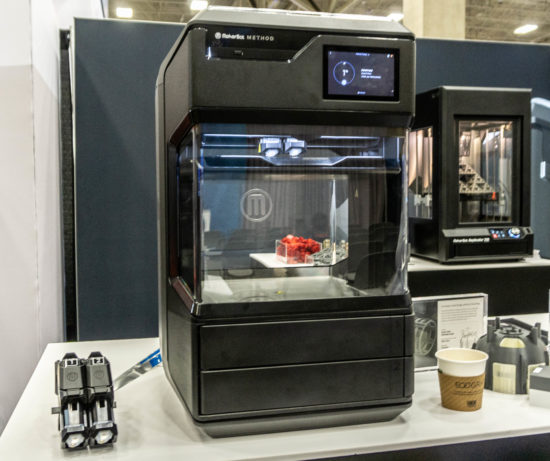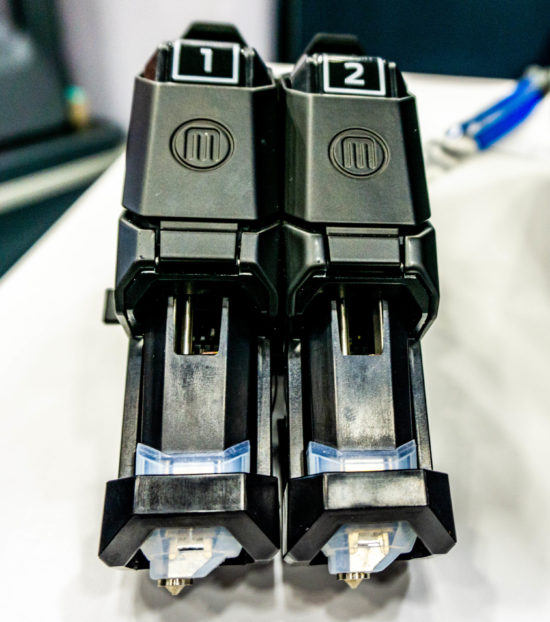New printer offers an entry-level alternative for professional use.
MakerBot is back, and they mean business.
In 2012, Bre Pettis made a very big splash on the 3D printer scene with his Replicator, which he was pitching as a household gadget. It came around right about the same time as 3D Systems Cube printer for consumers and for a short time, both devices broke the 3D printer market causing a flurry of excitement that was based on hype, and unrealistic expectations.
MakerBot eventually was bought by Stratasys and the company has continued to nurture the business. The Cube went away around 2015. And 3D printing went back to normal because, after all, it is still a pretty magical business that is transforming manufacturing.
MakerBot, based in Brooklyn, still has plenty of cool cred and it is staying true to its commitment to design and functionality with the introduction of its new Method printer. But this time, it’s targeted to small businesses, designers working on prototypes, and small part runs. CEO Nadev Goshen says that as the company reassessed the market, they came to understand there was a need for a product that sat somewhere between the barebones consumer product and expensive industrial printers.
A lot of those people are SolidWorks customers so MakerBot brought its new machine to SolidWorks World in Dallas. In addition to redefining target customer, MakerBot considered the challenges those customers are dealing with. First and foremost, the company recognized the problem of geometric accuracy. When making parts that have to fit together, precision is obviously important but it’s even difficult with some printers to make parts that are identical every time. Also, they took another look at support material and process to make sure supports were easy to break away. Finally, MakerBot felt it had to stay true to its vision of accessibility and ease of use.

At SolidWorks World, VP of Engineering, Dave Veisz, said that in designing the Method, they decided to go with a dual extruder approach that enables the part to be simultaneously built with support. The company notes that there are 21 sensors and a camera in the machine. Its ultra-rigid metal frame ensures the machine doesn’t flex during operation, which could distort the part being manufactured. Likewise, the base plate is engineered to be perfectly flat and its position is maintained with a system of magnets. The point, MakerBot wants you to get from all this, is that these are not the features of a typical entry-level printer.

The extruders are key to the Method design. Veisz says they were designed to ensure consistent heating as material comes through and to maintain a strong grip on the part as it’s being manufactured so no variation interferes with the geometric accuracy. A longer thermal core in the extruders means faster extrusion rates and smoother extrusion. In addition, the extruders are automatically calibrated and thanks to the systems software they know where they are in space.
MakerBot says the Method printer can produce parts with a dimensional accuracy of ±0.2 mm.
The Method will ship on March 22nd and is priced at $6,499.
In summary, it seems MakerBot has really not deviated from the original vision of the first Replicator, which was once distributed as low-cost a kit and was designed to be able to print its own replacement parts. Yes, the Method printer is a long way from the earliest replicators, which were essentially treasured toys of very geeky people. Instead, it is marketed as a “performance 3D printer” sold at a much lower price than printers in the same category says MakerBot. But, and this is a nice touch, those custom extruders on the Method were first built using MakerBot printers.
What do we think?
When Stratasys acquired MakerBot, the company recognized its new acquisition should be allowed to find its own market and maintain its start-up identity. Like, true entrepreneurs, Veisz and Goshen were manning the booth at SolidWorks World and they clearly love their new machine.
3D printing is still an emerging market. There were several new startups at SolidWorks World and the more established companies had new printers to show off. There are a wealth of methods and materials. There’s plenty of room for innovation. MakerBot seems to be looking for good ideas to make better.





